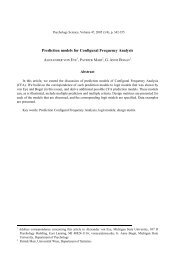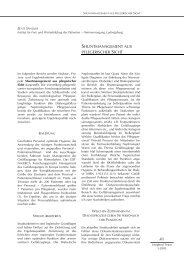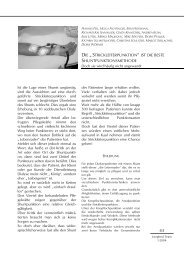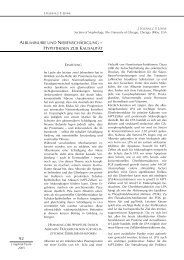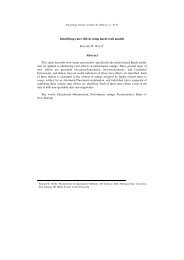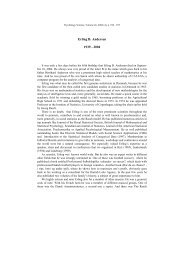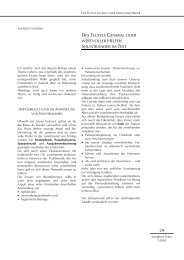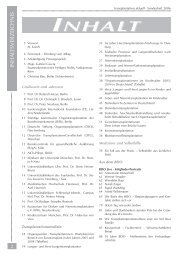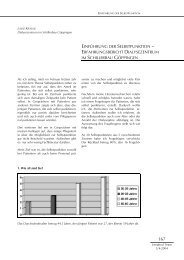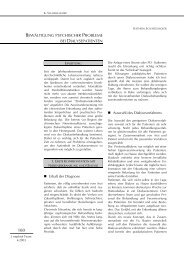Download PDF of the full article - Pabst Science Publishers
Download PDF of the full article - Pabst Science Publishers
Download PDF of the full article - Pabst Science Publishers
You also want an ePaper? Increase the reach of your titles
YUMPU automatically turns print PDFs into web optimized ePapers that Google loves.
Psychology <strong>Science</strong>, Volume 46, 2004, Supplement I, p. 199-205<br />
Creativity and its intrapsychic bounds<br />
TOMÁŠ KOVÁČ 1<br />
Summary<br />
The study deals with some <strong>the</strong>oretic issues as a result <strong>of</strong> investigations on talent and<br />
creativity development in Slovakia. In <strong>the</strong> second part some examples <strong>of</strong> two factoranalytical<br />
studies concerning intra-psychic bounds <strong>of</strong> creativity (differentiated into<br />
several factors) with sense <strong>of</strong> humor, prosocial behavior and coping with stress are<br />
presented.<br />
Key words: Creativity, talent, factor analysis, sense <strong>of</strong> humor, prosocial behavior,<br />
coping with stress, school achievement, soccer performance<br />
1<br />
Dr. Tomáš Kováč, PhD., Research Institute <strong>of</strong> Child Psychology and Pathopsychology, Trnavská 112,<br />
821 02 Bratislava, Slovak Republic<br />
Department <strong>of</strong> Psychology, Faculty <strong>of</strong> Philosophy, St. Cyril and Methodius University, J. Herdu 2,<br />
917 00 Trnava, Slovak Republik
200 T. Kováč<br />
Creativity and its intra-psychic bounds<br />
Creativity, as a matter <strong>of</strong> fact, is <strong>the</strong> only capability that distinguishes a man from o<strong>the</strong>r<br />
beings. There do exist <strong>the</strong> following three axioms (according to our long-term studies):<br />
1. Creativity is <strong>the</strong> ability <strong>of</strong> every human being.<br />
2. We can fi nd it in every human activity.<br />
3. It can be developed not only by special programs (what a luck for many <strong>of</strong> our<br />
collegues) but also throughout education or <strong>the</strong> family and last but not least it is<br />
infl uenced by <strong>the</strong> way and <strong>of</strong> course <strong>the</strong> quality <strong>of</strong> life.<br />
As known, creativity goes hand in hand with talent (or giftedness – we do not distinguishes<br />
<strong>the</strong>se two terms and use <strong>the</strong>m as synonyms, as according to <strong>the</strong> literature, <strong>the</strong>re are not very<br />
plausible differences in <strong>the</strong>oretical explanations). Maybe <strong>the</strong> highest one could be <strong>the</strong> socalled<br />
“creative talent”. The results <strong>of</strong> our investigations on talent development (Dočkal & T.<br />
Kováč, 1993) can be summarized in <strong>the</strong> following <strong>the</strong>sis:<br />
1. A gift (talent) is formed on <strong>the</strong> basis <strong>of</strong> genetic dispositions throughout life. The<br />
conditions <strong>of</strong> <strong>the</strong> environment and <strong>the</strong> very activity <strong>of</strong> an individual are signifi cant<br />
factors acting in its creation.<br />
2. Not every gifted child becomes an exceptional adult, but most adult talents behaved as<br />
talented individuals in <strong>the</strong>ir childhood.<br />
3. A gift regulates <strong>the</strong> activity <strong>of</strong> a human being. As a characteristic <strong>of</strong> a personality,<br />
a gift is in possession <strong>of</strong> every human being. It has a continual character in relationship<br />
to effectiveness. It may be quantifi ed by this criterion.<br />
4. The qualitative aspect <strong>of</strong> a gift is based on its structure which conditions <strong>the</strong> socalled<br />
type <strong>of</strong> talent (it is differentiated in accordance to <strong>the</strong> classifi cation <strong>of</strong> human<br />
activity)<br />
5. A gift is a multi-dimensional phenomenon. Its structure consists <strong>of</strong> a) a preconditioning<br />
constituent (somatic characteristics, abilities, skills, acquirements and competencies);<br />
b) an activating constituent (non-specifi c motivation, will attributes, personality<br />
orientation)<br />
6. Creativity is a signifi cant part <strong>of</strong> both constituents <strong>of</strong> talent (creative abilities, creative<br />
motivation). Ins<strong>of</strong>ar as creativity plays a signifi cant and dominant role in <strong>the</strong> structure<br />
<strong>of</strong> talent, we may speak about creative talent. As mentioned, we understand creativity<br />
also as a quality <strong>of</strong> every human being. A noncreative human being rarely exists (it<br />
may be in <strong>the</strong> most serious cases <strong>of</strong> olygophreny). Our results also show, that <strong>the</strong><br />
preschool age is <strong>the</strong> gate to <strong>the</strong> world <strong>of</strong> creativity.<br />
7. The particular components <strong>of</strong> ei<strong>the</strong>r constituents <strong>of</strong> talent possess a hierarchic<br />
orderliness that is also related to <strong>the</strong> type <strong>of</strong> talent. The most general components <strong>of</strong><br />
talent – which are involved in every kind <strong>of</strong> activity – are <strong>the</strong> intellectual abilities,<br />
creative abilities, as well as achievement motivation (a need for self-assertion). On<br />
inferior degrees <strong>of</strong> this hierarchy, <strong>the</strong>re are attributes which specify <strong>the</strong> respective<br />
type <strong>of</strong> talent. Never<strong>the</strong>less, some attributes may play a general role in <strong>the</strong> relation<br />
to one activity (a type <strong>of</strong> talent) a special role in relation to ano<strong>the</strong>r activity (a type <strong>of</strong><br />
talent).<br />
8. The differentiation <strong>of</strong> talents begins in a course <strong>of</strong> <strong>the</strong> development when <strong>the</strong> focus <strong>of</strong><br />
talent is being gradually shifted from its general characteristics onto <strong>the</strong> special ones.<br />
Some common traits, however, remain persevered.
Creativity and its intrapsychic bounds<br />
201<br />
9. In making talent identifi cation and development, it is necessary to intercept all levels<br />
<strong>of</strong> hierarchy that participate in a respective activity. If a young sport talent is to be<br />
perspective for example, he/she has to be endowed with <strong>the</strong> average level <strong>of</strong> intellectual<br />
abilities, not only with <strong>the</strong> attributes that are specifi c to <strong>the</strong> respective type <strong>of</strong> sports.<br />
A good musician may be <strong>the</strong> one who, in addition to <strong>the</strong> instrument technique, is able<br />
to develop, e. g. certain general artistic abilities.<br />
10. A signifi cant part <strong>of</strong> whatever talent during childhood is <strong>the</strong> wide spectrum <strong>of</strong> <strong>the</strong><br />
child`s interests and activities. The precocious specialization in most cases inhibits<br />
talent development.<br />
11. Preconditioning constituent and activating constituent <strong>of</strong> talent infl uence each o<strong>the</strong>r.<br />
Children with higher level <strong>of</strong> motivation in concrete activity develop <strong>the</strong>ir abilities<br />
quicker. On <strong>the</strong> o<strong>the</strong>r hand, adequate motivation can develop easier in children with<br />
higher abilities.<br />
12. There are certain sensitive periods for development <strong>of</strong> particular types <strong>of</strong> talent, but <strong>the</strong><br />
development <strong>of</strong> talent is as a matter-<strong>of</strong>-fact strictly individual.<br />
Since its beginnings, researches on talent and creativity have focused on <strong>the</strong> recognition<br />
<strong>of</strong> <strong>the</strong>ir structures. Even <strong>the</strong> classic researchers <strong>of</strong> creativity, J. P. Guilford (1971) and E. P.<br />
Torrance (1964) or R. B. Cattell (1971), had followed this direction. From past but also present<br />
archives <strong>of</strong> available statistical approaches, mostly <strong>the</strong> factor analysis appeared to have been<br />
applied here. In spite <strong>of</strong> <strong>the</strong> fact that <strong>the</strong> very discovery <strong>of</strong> <strong>the</strong> creative personality structure <strong>of</strong><br />
a talent is considered to be crucial in <strong>the</strong> developmental stage (e. g. D. Kováč, 1985; Dočkal,<br />
1995), <strong>the</strong> current research in Slovakia is not following this direction.<br />
Some years ago, a Private Sports Secondary Grammar School has been established<br />
focusing on soccer. Boys placed in <strong>the</strong> fi rst grade were mostly selected according to soccer<br />
standards with regard to talent examinations. Their fulfi llment was assigned by soccer<br />
experts – instructors. Two years have passed since and at this secondary school <strong>the</strong>re were<br />
at that time 60 boys aged 14 to 17 years and every grade represented (three classes) one<br />
independent soccer team.<br />
The curriculum includes regular subjects and soccer activities as well as some approaches<br />
to psychological development <strong>of</strong> creativity. Since soccer, as a collective game, besides<br />
certain standard skills, is also based upon creativity, we decided to mostly focus on creativity<br />
preconditions in <strong>the</strong> way <strong>the</strong>y are measured by relevant tests. We tried to fi nd out, by use <strong>of</strong><br />
few performances and self-report methods, how this complex system <strong>of</strong> functioning works in<br />
<strong>the</strong> development <strong>of</strong> soccer talent.<br />
Several methods <strong>of</strong> assessing creativity were used: 1. Urban`s Creativity Test – fi gural<br />
version (Urban & Jellen, 1993) – a German test based upon principles <strong>of</strong> unfi nished pictures.<br />
Unlike <strong>the</strong> regular performance creativity tests (divergent thinking), it focuses on some<br />
personality-cognitive dimensions (e. g. willingness to undergo risk, complexity <strong>of</strong> view).<br />
Eleven items are evaluated and <strong>the</strong>y are all included in <strong>the</strong> resulting scores (maximum <strong>of</strong><br />
72 points). 2. Second subtest <strong>of</strong> fi gural version <strong>of</strong> Torrance`s Tests for Creative Thinking<br />
(Jurčová, 1984). Fluency, fl exibility and originality were evaluated. 3. Pictographs (Leontiev<br />
& Gippenrejter, 1972) – assessment <strong>of</strong> <strong>the</strong> so-called creative memory. A list <strong>of</strong> 15 abstract<br />
nouns is read to <strong>the</strong> subjects in fi ve-second intervals. Their task is to register every word<br />
by a single graphic sign – a pictograph. However, letters or numbers cannot be used. After<br />
engaging in ano<strong>the</strong>r activity (lasting cc 10 minutes) <strong>the</strong>y should assign <strong>the</strong> corresponding<br />
words to <strong>the</strong>ir signs. The number <strong>of</strong> correct assignments creates <strong>the</strong> entire score.
202 T. Kováč<br />
Besides this, we also administered <strong>the</strong> School Stressors Inventory for Adolescents (SSIA)<br />
by J. P. Fanshav and P. C. Burneth in <strong>the</strong> Slovak adaptation by I. Sarmány Schuller. It focuses<br />
on coping with various qualities <strong>of</strong> stressors that occur in a school setting.<br />
O<strong>the</strong>r variables were <strong>the</strong> age <strong>of</strong> <strong>the</strong> subjects, <strong>the</strong>ir average school achievement, and<br />
evaluation by <strong>the</strong>ir soccer instructors. The instructors devided <strong>the</strong> boys in three performance<br />
categories and mark 1 represented <strong>the</strong> best performance.<br />
59 boys altoge<strong>the</strong>r participated in <strong>the</strong> research from 1 st , 2 nd and 3 rd grades <strong>of</strong> <strong>the</strong> school<br />
aged 14 to 17 years.<br />
The data obtained underwent a statistical analysis by <strong>the</strong> method <strong>of</strong> Rotating Factor<br />
Analysis – Varimax (Koschim et al., 1992). The number <strong>of</strong> factors that should be extracted by<br />
rotation was addressed by <strong>the</strong> so-called Ludwig`s Criterion (Jahn & Vahle, 1970).<br />
The factor analysis in <strong>the</strong> Statgraphics Program titrated two factors. Toge<strong>the</strong>r with<br />
saturating <strong>the</strong> particular variables, <strong>the</strong>y are presented in Table 1. As we can see, <strong>the</strong> fi rst<br />
factor is most saturated by creativity variables. Therefore, it is logical, that we called it – <strong>the</strong><br />
Factor <strong>of</strong> creativity. In <strong>the</strong> negative relation with creativity we can see a putative position<br />
<strong>of</strong> <strong>the</strong> variables <strong>of</strong> school achievement and soccer effi ciency. However, <strong>the</strong> negative sign is<br />
based upon <strong>the</strong> fact that school achievement as well as soccer effi ciency were evaluated on <strong>the</strong><br />
scale where number 1 represented <strong>the</strong> best performance. From this it is clear that better school<br />
marks and performances on <strong>the</strong> playground went hand in hand with growing creativity. The<br />
above-mentioned fi nding is nontraditional to a certain extent because <strong>the</strong> data from literature<br />
tend to contradict (T. Kováč, 1980; Zelina & Zelinová, 1990). This means that combining<br />
school education with active sports activity enables creative individuals to develop <strong>the</strong>ir<br />
talent more effectively and vice versa. This also underlines <strong>the</strong> fact that coping with stress<br />
is in negative relationship with creativity (here applies: <strong>the</strong> higher scores, <strong>the</strong> worse coping<br />
with stress). The second factor is mostly saturated by variables <strong>of</strong> creative memory, coping<br />
with stress, performances in soccer, and age. Since all above-listed variables are in a positive<br />
relationship, this factor can presumably be called a barrier memory. The better <strong>the</strong> memory <strong>of</strong><br />
<strong>the</strong> subjects, <strong>the</strong> worse <strong>the</strong>ir coping with stressors as well as soccer effi ciency. We can assume<br />
that when subjects remember failures, this negatively infl uences <strong>the</strong>ir perception <strong>of</strong> school<br />
stress and functioning <strong>of</strong> a player on <strong>the</strong> fi eld – it shakes his self-confi dence. Since older boys<br />
did “experience” more in both areas, <strong>the</strong> coherence with age is easier to understand. The weak<br />
saturation by creativity variables and achievement prove that stronger negative experiences<br />
infl uence soccer talent more signifi cantly. This fi ndings can be a warning for all those who<br />
work with talents <strong>of</strong> this kind to apply a method <strong>of</strong> praises in a wider extent.<br />
In conclusion we can assume that:<br />
1. Creativity is a distinct feature <strong>of</strong> soccer talent<br />
2. Creativity makes it easier to cope with stress<br />
3. Negative experiences in <strong>the</strong> given area inhibit <strong>the</strong> development <strong>of</strong> a soccer talent<br />
The results <strong>of</strong> this research are considered to be preliminary. To have a wider platform,<br />
a control group would be necessary, and, <strong>of</strong> course, <strong>the</strong> expansion <strong>of</strong> <strong>the</strong> set <strong>of</strong> research<br />
methods (personality, cognitive styles). Never<strong>the</strong>less, we think that we pointed in <strong>the</strong> direction<br />
where <strong>the</strong> development <strong>of</strong> talents could go. Teaching at our secondary schools is too saturated<br />
with high intensity and <strong>the</strong> absence <strong>of</strong> developing creative thinking. In such a condition, many<br />
talents evade, i. e. resign. The goal <strong>of</strong> all interested parties should be to interlude this elusion.
Creativity and its intrapsychic bounds<br />
Table 1:<br />
FACTORS<br />
Factor 1<br />
Originality (TTCT) ,896<br />
Fluency (TTCT) ,890<br />
Flexibility (TTCT) ,886<br />
Creativity (Urban) ,883<br />
School Achievement - 0,758<br />
Soccer Performance - 0,424<br />
Creative Memory (pictographs) ,381<br />
Coping with Stress (SSIA) - 0,251<br />
Age<br />
Factor 2<br />
,212<br />
Creative Memory (pictographs) ,648<br />
Coping with Stress (SSIA) ,627<br />
Age ,527<br />
Soccer Performance ,510<br />
Creativity (Urban) ,199<br />
203<br />
The classics <strong>of</strong> psychology <strong>of</strong> creativity see <strong>the</strong> sense <strong>of</strong> humor as being among <strong>the</strong> most<br />
basic attributes, although <strong>the</strong> mainstream <strong>of</strong> <strong>the</strong> research activities did not follow this direction<br />
too much (Koestler, 1964; Torrance, 1979; Isaksen, 1987; Treffi nger, 1987). Empiricism<br />
shows that in <strong>the</strong> „historical top <strong>of</strong> ten“, <strong>the</strong>re were many creative people who were known<br />
for <strong>the</strong>ir wittiness and sense <strong>of</strong> humor. In my previous study (T. Kováč, 1998) with younger<br />
subjects <strong>the</strong> studied phenomena seem to be connected with each o<strong>the</strong>r. The investigation <strong>of</strong><br />
<strong>the</strong> relationships between creative abilities and sense <strong>of</strong> humor is <strong>the</strong>refore adequate and,<br />
considering <strong>the</strong> present imperfections in <strong>the</strong> methodology, it is also justifi able.<br />
73 high school students aged 15 to 18 years took part in this modest investigation. The<br />
following variables were assessed:<br />
1. Creativity as measured by Urban`s Creativity Test (Urban & Jellen, 1993)<br />
2. Creative (respectively divergent) thinking as assessed by <strong>the</strong> second subtest <strong>of</strong><br />
<strong>the</strong> TTCT (Jurč3. ová, 1984) – fl uency, fl exibility and originality were taken into<br />
account.<br />
3. Verbal divergence – The Test <strong>of</strong> Unusual Use (Guilford, 1971) <strong>of</strong> a football (fl uency,<br />
fl exibility and originality)<br />
4. Creative coping (by a modifi cation <strong>of</strong> Guilford`s Consequences Test, 1971). The<br />
stimulus was <strong>the</strong> question: „How can you explain to your teacher that you are not<br />
prepared for <strong>the</strong> lesson?“ – again fl uency, fl exibility and originality were assessed.<br />
5. Sense <strong>of</strong> humor as measured by Sense <strong>of</strong> Humor Scale (Thorson & Powell, 1993),<br />
with it`s four factors: 1. achievement <strong>of</strong> social aims by humor, 2. coping with humor,<br />
3. attitudes towards people producing humor, and 4. appreciation <strong>of</strong> humor. The whole<br />
scale score can also be used.
204 T. Kováč<br />
6. Sociability or tendencies towards prosocial behavior, in o<strong>the</strong>r words, by a fi gural<br />
projective method SOCAG (Doč8. kal, 1998).<br />
7. School results – actual average marks in Slovak, English, German and Maths.<br />
The obtained data underwent statistics <strong>of</strong> rotated factor analysis by <strong>the</strong> Varimax method<br />
(Koschim et al., 1992). The number <strong>of</strong> factors extracted by <strong>the</strong> rotation was determined by <strong>the</strong><br />
so-called Ludwig`s criterion (Jahn & Vahle, 1970).<br />
The factor analysis titrated two factors to which all <strong>of</strong> <strong>the</strong> variables have contributed.<br />
Table 2 documents <strong>the</strong>se results.<br />
We could give <strong>the</strong> fi rst factor <strong>the</strong> most suitable name: The Factor <strong>of</strong> Witty Coping with<br />
Social Situations. It is saturated by variables <strong>of</strong> creative coping, sense <strong>of</strong> humor and creativity<br />
(as measured by Urban`s Creativity Test). The school mark is in contradiction, which means that<br />
creative and witty students cope with <strong>the</strong> school situation relatively well as mirrored by <strong>the</strong>ir<br />
marks. One can say that creativity and humor are one <strong>of</strong> <strong>the</strong> ways to cope with school stress. The<br />
second factor was named The Factor <strong>of</strong> Prosocial Creativity as it is most saturated by variables<br />
<strong>of</strong> divergence (or verbal or nonverbal creativity) and tendencies towards prosocial behavior by<br />
means <strong>of</strong> humor, too. It can be said, <strong>the</strong>refore, that <strong>the</strong> second factor improved <strong>the</strong> connection<br />
between creativity and sense <strong>of</strong> humor, too. In addition, it was shown, that both phenomena<br />
studied correspond also to <strong>the</strong> tendencies towards prosocial behavior. This fact could be a notice<br />
for some teachers, who, up to this time, have not been using (even restricted) humor in <strong>the</strong>ir<br />
educational work. In this way <strong>the</strong>y prohibit <strong>the</strong> creative development <strong>of</strong> <strong>the</strong>ir pupils.<br />
The factor analysis confi rmed, that creativity and sense <strong>of</strong> humor go hand in hand, so to<br />
speak. Individuals with higher creativity level and sense <strong>of</strong> humor showed clearer tendencies<br />
towards prosocial behaviour. Verbal and fi gural factors <strong>of</strong> divergent thinking are a bit different<br />
(as referred to intelligence). That is why <strong>the</strong>y did not participate in an equal way in both<br />
titrated factors. Especially <strong>the</strong> verbal factors <strong>of</strong> divergent creative coping with school situation<br />
showed this difference. Creativity with humor form intrapsychological bonds (D. Kováč,<br />
1996), which in view <strong>of</strong> <strong>the</strong> interfunctional approach are worthwhile to study in more depth.<br />
Table 2:<br />
FACTORS<br />
Factor 1<br />
Creative Coping Fluency ,833<br />
Creative Coping Flexibility ,862<br />
Creative Coping Originality ,840<br />
Mean <strong>of</strong> School Results - 0,772<br />
Sense <strong>of</strong> Humor (whole scale score) ,742<br />
Urban`s Creativity Test ,718<br />
Factor 2<br />
Divergent Figural Flexibility ,892<br />
Divergent Figural Fluency ,875<br />
Tendencies towards Prosocial Behavior ,626<br />
Divergent Figural Originality ,611<br />
Archievement <strong>of</strong> Social Aims by Humor ,603
References<br />
Creativity and its intrapsychic bounds<br />
205<br />
1. Cattell, R. B.: Faktorenanalyse. In: Arnold, W., Eysenck, H. J. & Meili, R. (Eds.): Lexikon der<br />
Psychologie. Freiburg-Basel-Wien, Herder 1971, 578 – 589.<br />
2. Dočkal, V.: Nadanie a tvorivosť: vzťah genetiky a prostredia. Psychológia a patopsychológia<br />
dieťaťa, 1995, 1, 22 – 23.<br />
3. Dočkal, V.: Pokus o zisťovanie sociability semiprojektívnou screeningovou metodikou. In:<br />
Človek na počiatku nového tisícročia. Bratislava, SPS pri SAV 1998, 57 – 59.<br />
4. Dočkal, V. & Kováč, T.: On talent development. Studia psychologica, 1993, 2, 193 – 194.<br />
5. Guilford, J. P.: The Nature <strong>of</strong> Human Intelligence. London, McGraw-Hill 1971.<br />
6. Isaksen, S. G.: Frontiers <strong>of</strong> Creativity research: beyond <strong>the</strong> Basics. Buffalo, Bearly Limited<br />
1987.<br />
7. Jahn, W. & Vahle, H.: Faktorenanalyse. Berlin, Wirtschaft 1970.<br />
8. Jurčová, M.: Torranceho test tvorivého myslenia. Bratislava, Psychodiagnostické a didaktické<br />
testy 1984.<br />
9. Koestler, A.: The Act <strong>of</strong> Creation. New York, McGraw-Hill 1964.<br />
10. Koschim, F. et al.: Statgraphics aneb statistika pro každého. Praha, Grada 1992.<br />
11. Kováč, D.: Teória všeobecnej psychológie. Bratislava, Veda 1985.<br />
12. Kováč, D.: Základné kategórie psychológie. Trnava, TU 1996.<br />
13. Kováč, T.: Tvorivý a menej tvorivý pubescent: faktorovo-analytická štúdia. In: Psychologické<br />
výskumy v ČSSR. Praha, ČSPS pŘi ČSAV 1980, 198 – 200.<br />
14. Kováč, T.: Creativity and prosocial behavior. Studia Psychologica, 1998, 4, 326 – 330.<br />
15. Leontiev, A. N. & Gippenrejter, J. B.: Praktikum po psikhologii. Moskva, MGU 1972.<br />
16. Thorson, J. A. & Powell, F. C.: Development and validation <strong>of</strong> a Multidimensional Sense <strong>of</strong><br />
Humor Scale. Journal <strong>of</strong> Clinical Psychology, 1993, 1, 13 – 23.<br />
17. Torrance, E. P.: Exploration in creative thinking in <strong>the</strong> early school years: a progress report.<br />
In: Taylor, C. W. & Barron, F. (Eds.): Scientifi c creativity: its recognition and development.<br />
New York, Wiley 1964, 173 – 183.<br />
18. Torrance, E. P.: The search for satori and creativity. Buffalo, Creative Education Foundation<br />
in Association with Bearly Limited 1979.<br />
19. Treffi nger, D.: Introduction: An orientation to <strong>the</strong> frontiers <strong>of</strong> creativity research. In: Isaksen,<br />
S. G. (Ed.): Frontiers <strong>of</strong> Creativity Research: Beyond <strong>the</strong> Basic. Buffalo, Bearly Limited<br />
1987, 8 – 9.<br />
20. Urban, K. K. & Jellen, H. G.: Test zum schöpferischen Denken zeichnerisch. Hannover,<br />
HEFE Unversität Hannover 1993.<br />
21. Zelina, M. & Zelinová, M.: Rozvoj tvorivosti detí a mládeže. Bratislava, SPN 1990.



